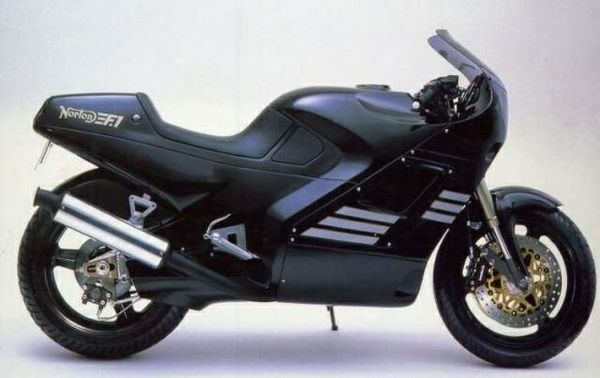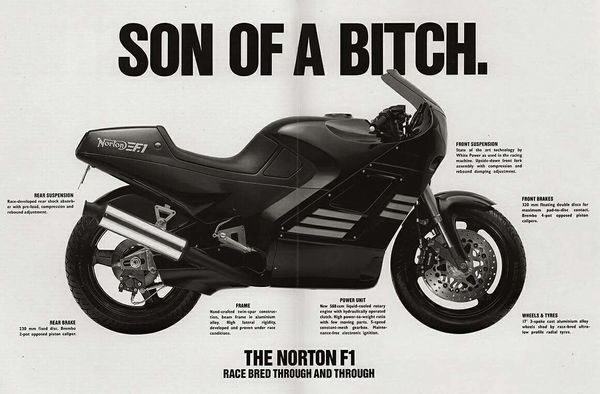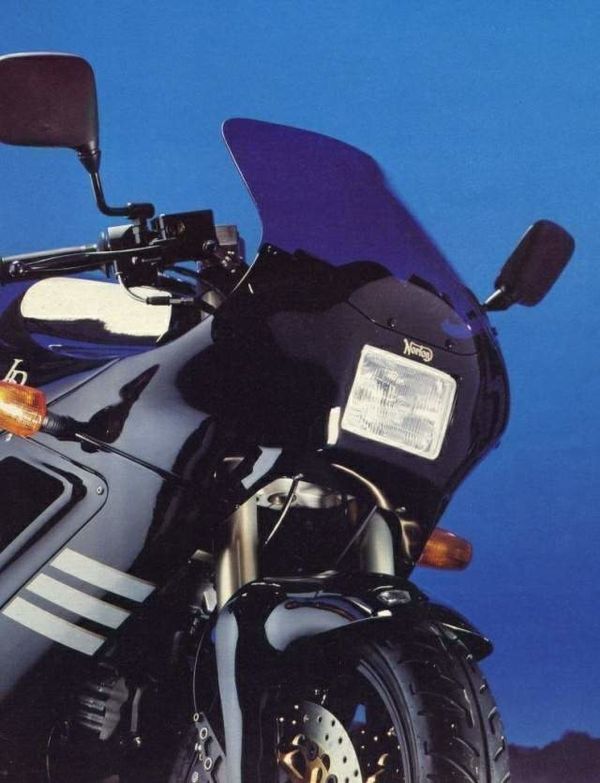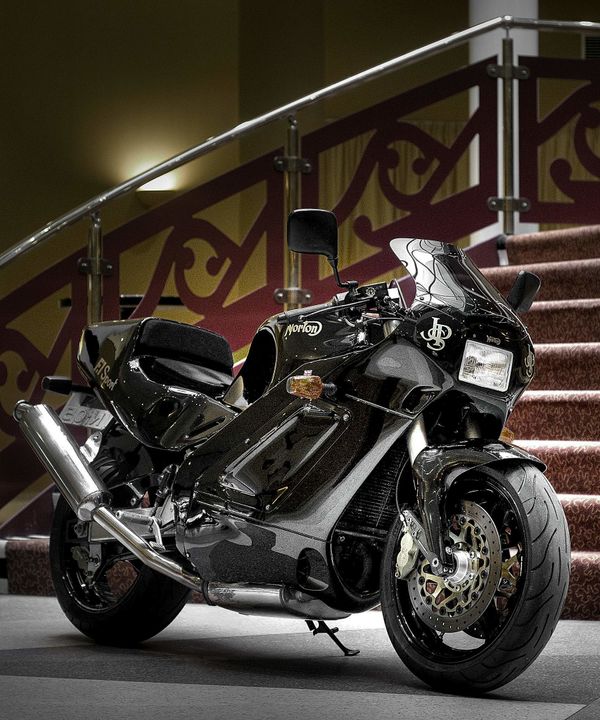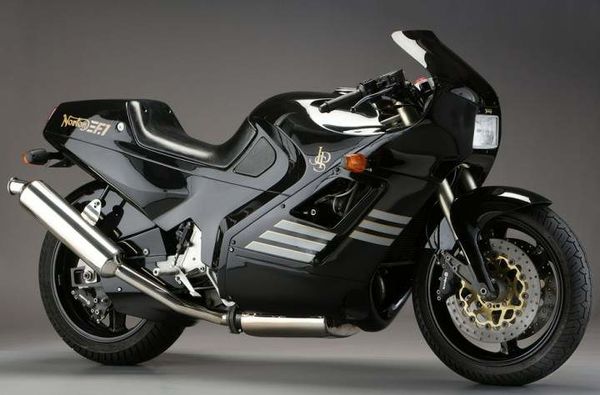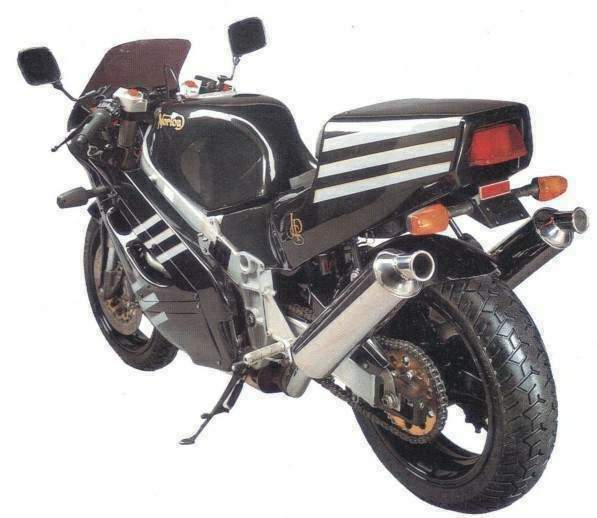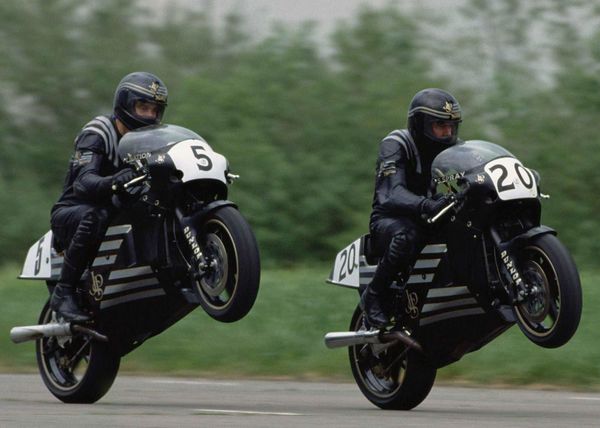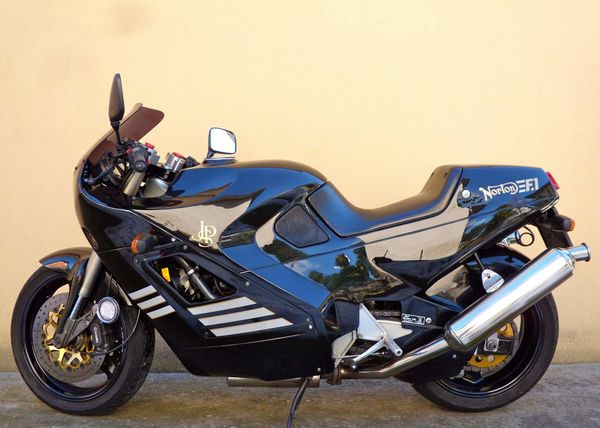Norton FI
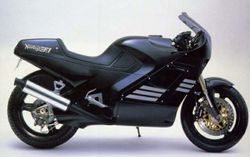 |
|
| Norton FI | |
| Manufacturer | |
|---|---|
| Production | 1989 |
| Engine | Twin chamber rotary |
| Compression ratio | 9.0:1 |
| Top Speed | 233 km/h / 145 mph |
| Transmission | 5 Speed |
| Suspension | Front: WP upside-down forks, compression and rebound damping adjustable. Rear: WP monoshock, compression and rebound damping adjustable. |
| Brakes | Front: 2 x Ø320 mm discs Rear: Single Ø230 mm disc |
| Front Tire | 120/79 ZR17 |
| Rear Tire | 170/60 ZR17 |
| Weight | 192 kg / 423 lbs (dry), |
| Fuel Capacity | 20 L / 5.2 US gal |
| Manuals | Service Manual |
It could reach a top speed of 233 km/h / 145 mph.
Engine[edit | edit source]
The engine was a Liquid cooled cooled Twin chamber rotary. The engine featured a 9.0:1 compression ratio.
Chassis[edit | edit source]
It came with a 120/79 ZR17 front tire and a 170/60 ZR17 rear tire. Stopping was achieved via 2 x Ø320 mm discs in the front and a Single Ø230 mm disc in the rear. The front suspension was a WP upside-down forks, compression and rebound damping adjustable. while the rear was equipped with a WP monoshock, compression and rebound damping adjustable.. The FI was fitted with a 20 L / 5.2 US gal fuel tank. The bike weighed just 192 kg / 423 lbs.
Photos[edit | edit source]
Overview[edit | edit source]
Norton F1 JPS
It was the howl that stayed in the memory; a smooth,
high-pitched scream that ripped from twin mufflers as the Norton F1 rotary
motor hit 6000rpm and surged toward the redline with renewed thrust. The F1
distinctive exhaust note emphasized that this bike was different not only
from previous Nortons but also from every other sportster ever built.
The launch of the F1 in 1990 was remarkable in itself. Norton's comeback had
begun a few years earlier with the release, after 15 years of rotary
development, of the Classic roadster.
The touring Commander followed, and
public interest in Norton snowballed when enthusiastic workers built an
alloy-framed rotary racer that won two national championships in 1989.
A roadgoing version was the obvious next step. The F1 was powered by a
Commander engine, turned back-to-front, fitted with Mikuni carburetors and
uprated with the five-speed gearbox from Yamaha's FZR1000. Enlarged ports
and revised timing helped lift output from 85 to 95bhp at 9500rpm. The
frame, built by local specialists Spondon Engineering, was similar to the
race bike's but stronger and had slightly more conservative steering
geometry. Dutch firm White Power provided the multi-adjustable upside-down
forks and shock. Brembo brakes and Michelin radials completed an up market
package.
Styling incorporated smooth bodywork that hid much of the
technology but left space for the cigarette-packet logos of race-team
sponsors JPS. Riding position was sporty, with wide clip-ons and a single
seat. The F1 power and weight figures were similar to a typical Japanese
600, and so was its 145mph to the road, the rotary felt totally different,
though, smoothness, generous midrange punch and high-rev howl.
But there were rough edges; was thirsty, its engine snatched at low revs and were overheating, and ground clearance was poor. The hand-built F1 was also extremely expensive. Norton addressed this a year later with the slight F1 Sport, which used simpler bodywork and lower parts. The Sport was a little less sleek and sophisticated, but like the F1, it was quick, agile and distinctive.
Source of review: Roland Brown
The worlds only rotary-engined superbike was hyper-expensive about US$45,000 back in the early 90s but went like blazes. Unlike a conventional piston driven engine, the F1s 588cc, liquid-cooled rotary engine had no reciprocating mass, and produced 95bhp@9500rpm in a smooth, linear fashion. The Norton F1 RCW588 won the British F1 series in 1989, and the bike was also raced in the Isle of Man TT races. The British Motorcycle Land Speed Record was also set at 307km/h in 1991 using a Norton rotary engine. Steve Spray and Trevor Nation were the two British riders who raced the F1 successfully in various events in the UK.
As you would expect with an all-new engine design, Norton had various problems with the F1's rotary engine, and the British company never really had the money to sort those problems out completely. If only Norton had Honda's financial muscle, the world of very fast motorcycles might have been a different place today
OverviewBack in the late-1980s / early-1990s, the
rotary-engined Norton F1 was pretty much the most exotic superbike in the world.
Yes, there were others, like the Honda
, Yamaha OW01 and the Bimota YB4, but none of those machines had what
the Norton F1 had - a 588cc liquid-cooled twin-rotor rotary engine that revved
like crazy, producing a frenzied 85bhp and pushing the bike to a top speed of
225kph. The F1's successor, the F1 Sport was even more powerful and racing
versions of the bike notched up many race wins, including a particularly
memorable win at the 1992 Isle of Man TT. With its Spondon-designed aluminum
twin-spar chassis, PVM wheels, Brembo brakes and adjustable WP suspension, the
Norton F1 definitely wasn't messing around - it meant business.
We've always been big fans of the . Apart from its rotary engine, we also love its styling - the F1's fully-enclosed fairing and its iconic black, gray and gold 'John Player Special' paintjob make it stand out from from other 1980s/1990s machines. The bike was designed by British designers, Richard Seymour and Dick Powell of seymourpowell, a London-based industrial design outfit that was set up in 1984. We thought it would be fascinating to get their take on the Norton F1 now, about 25 years after the machine was launched. So we sent them a few questions, and here are some excerpts from what Dick Powell, co-founder of , had to say about the legendary Norton F1:
On how it all started
Seymourpowell officially started in 1984. Both Richard and I were at the Royal College of Art. Our first motorcycle client was Yamaha, for whom we did many projects during the '80s and early-'90s, including building full-size working prototypes of concept bikes. We also worked for BMW, and later created the worlds first hydrogen-fuelled motorcycle called ENV.
On their love for motorcycles
I have had a full license since I was 16 years old and have been riding bikes ever since. I have three bikes - a Honda RC30, a Yamaha R1 and a KTM Adventure. Richard too has been a biker all his life!
On how they got started working for Norton
Our first contact with Norton came via The Design Council, which was running a service for the industry called FCS (Funded Consultancy Service), whereby a company could commission design work and have a significant part of the cost funded by the government. This was before Norton had officially launched their air-cooled Wankel engine bike, and they were in the process of developing the water-cooled Wankel engine. We were asked to consider the design implications for the water-cooled engine but, in the event, we went back to them with a full strategic report outlining what they should be doing.
That report sat around for a while until the business, verging on liquidation, was bought by Phillipe Le Roux. He turned up our report (he said he found it in a drawer!) and saw much common sense in it.
On problems with the Wankel rotary engine and how they dealt with those problems
Nortons Wankel engine, in both air-cooled and water-cooled versions was hampered by poor breathing. Air that eventually ended up being mixed with fuel had to pass through a labyrinthine route which included passing through the middle of the rotor shaft. This both constricted the incoming air and made it far too hot. On our first visit to Lichfield with Le Roux, we met who, in his own time, was trying to develop a racing version of the engine. Brians brilliant idea was to put what he called an exhaust ejector on the exhaust; this was effectively a venturi whose low pressure dragged the necessary cooling air through the internals which, in turn allowed air for the carbs to arrive unrestricted. This simple device released masses of horsepower (from memory, almost doubling the engine output). Our strongest recommendation to Le Roux was to make Brians personal project into a formal part of Norton strategy: that they go racing to demonstrate the technology and underpin the later launch of a sports bike.
We also put them in touch with Spondon, who had built chassis for SP before, and the project took off with the results that everyone knows about. But, the immediate and urgent need was to get the water-cooled engine into a viable motorcycle with a ready market - this being the police bike, which later became a consumer machine called the Commander. We recommended that because already had a close relationship with the Police (some air-cooled bikes had already been supplied to them) and no dealer network was needed to start generating some cash.
Following the police bike, we got the go ahead to start on the sportsbike. By then, the racing team had been formed with JPS sponsorship.
On the design brief given to them by Norton, for designing the F1
The brief was to turn the race bike into a sportsbike, using as many off the shelf parts as possible. What we hadnt realised at the beginning was that a road machine could not use Brians power liberating exhaust ejector for reasons of noise (anyone who witnessed the racers can testify to that!) and emissions (a consequence of using oil mist for lubrication). So the promise of a high performance sports machine was neutered before we started and that, more than any other single thing, dogged the bike thereafter. Beyond that, we wanted to keep as much of the racer as was possible including, of course, the Spondon chassis, the rotary engine and ancillaries. Apart from the bodywork, most of the other bits came from various Yamahas I think!
Norton F1 JPS
On the Norton F1's fully-enclosed fairing and its futuristic design
We had recently done a Futures' study for Yamaha and identified a growing trend
toward aerodynamic enclosure. From memory, I think Hondas first CBR600 had just
been launched and, around the same time, their CBR1000F and, of course, Bimota's
DB1. Both Richard and I rode
(me an
SB4 and Rich an HB2), both of which had one-piece bodies, which covered the real
tank. All these bikes pointed towards more and more aerodynamic bodywork as a
future direction. Additionally, bodywork was a good idea to keep mechanical
noise at bay and, looking ahead, allowed for future bikes, which could
capitalise on existing internals with investment only needed for bodywork
variations.
We felt that just doing a straight race replica was not the right thing to do for Norton. For a start, we didnt now how successful racing was going to be and tying sales to race track success seemed risky. And second, the Japanese were all over that, so it would be hard to compete with them on price. We felt the bike deserved a new identity which was more Porsche than straight race-replica; more sophisticated in the sense that, being expensive, it needed to sell to bikers who wanted something a bit more exclusive and less race honed (like a Bimota or, back then, a Ducati).
The original vision was for a very enclosed bike where the form of the rider was visible, as if moulded into the bodywork. The rear hugger was quite groundbreaking, tidying up the airflow exiting the engine and from under the bike. To the designers eye, this served to integrate the bike into one whole, seamless form.
On the response to the F1 when it was launched
I remember the launch at Earls Court (we built the show bike) where there was a huge buzz about it. And yes, it was thought to be contemporary but not, I think, too radical. We were immensely proud of it (and still are!) We won a Design Week Award Best of Show for it and Richard did a brilliant ad, titled Son of a Bitch, which Norton got cold feet about and barely ran. There was a strong feeling that the bike represented a new start (again!) for Norton and there was a will for the business to succeed, and a national fervour for that helped, it must be said, by success on the racetrack.
On his own experience of riding the Norton rotary-engined racebike
I remember well showing up at Mallory, where they were testing, to ride the race bike where, under the worried gaze of Brian and the amused gaze of Trevor Nation, I lurched around Mallory in my ACU novices pink jacket. I hadnt ever ridden a bike on slicks and I hadnt ever ridden with a reversed gear-change, but I had done track days at Mallory and knew my way around. With Brians instructions to not bin it ringing in my ears, I still managed to lock it up going into the hairpin (that reverse gear change!) but managed to enjoy a few laps at a very modest pace!
On his thoughts on current Norton motorcycles
I love the new bikes - they have captured the zeitgeist of the times where the retro '50s and '60s based café-racers are finding a market with people who want to capture some of the magic of a former time. Retro trends tend to reach back to a point in time just beyond peoples direct personal experience. Norton need to bear that in mind when thinking about what kind of bike to develop - they clearly understand this, and the difficulty of competing with brands with huge facilities and capability!
On how doing a similar project for Norton now would be different from how it was back then
If the F1 had had the power of the race bike, it would have been a completely different story - winning on track would have translated to sales, but there was no denying that it was underpowered for what it purported to be. And this at a time when buyers were really beginning to understand that they could have a real racer on the road. So yes, doing a similar project for now, it would be completely different!
On some of his own favourite motorcycles and what excites him about possible future developments in the world of motorcycling
I love the design and engineering of the and, for the same reason, Hondas exclusive . I think that the most important development in all future vehicles (not just bikes) will be batteries. They will get lighter, smaller and ever more powerful with, eventually, recharge cycles which make them a viable alternative to petrol as the technologies mature. Thats exciting for designers, as the architecture (or packaging) is completely different and that, in turn, will bring exciting new opportunities!
Source
| Make Model. | Norton F1 JPS |
|---|---|
| Year | 1989 |
| Engine Type | Twin chamber rotary |
| Displacement | 588 cc / 35.9 cu in |
| Compression | 9.0:1 |
| Cooling System | Liquid cooled |
| Exhaust | Stainless steel |
| Induction | 2 x Ø34 mm Mikuni BDS downdraft carburetors |
| Starting | Electric |
| Max Power | 67.1 kW / 90 hp @ 9000 rpm |
| Max Torque | 77.3 Nm / 7.88 kgf-m / 57 ft-lb @ 7500 rpm |
| Transmission | 5 Speed |
| Final Drive | Chain |
| Front Suspension | WP upside-down forks, compression and rebound damping adjustable. |
| Rear Suspension | WP monoshock, compression and rebound damping adjustable. |
| Front Brakes | 2 x Ø320 mm discs |
| Rear Brakes | Single Ø230 mm disc |
| Front Tire | 120/79 ZR17 |
| Rear Tire | 170/60 ZR17 |
| Dry Weight | 192 kg / 423 lbs |
| Fuel Capacity | 20 L / 5.2 US gal |
| Consumption Average | 7.8 L/100 km / 12.8 km/l / 30 US mpg |
| Top Speed | 233 km/h / 145 mph |
Videos[edit | edit source]
External Links[edit | edit source]
- http://www.fasterandfaster.net/2012/03/battle-of-v4s-honda-vfr750r-rc30-vs.html
- http://www.fasterandfaster.net/2015/06/honda-unveil-us184000-rc213v-s-motogp.html
- http://www.fasterandfaster.net/2013/10/brian-crighton-we-plan-to-make-range-of.html
- http://www.seymourpowell.com/
- http://www.fasterandfaster.net/search/label/Norton
- http://www.fasterandfaster.net/2015/01/ducati-1299-panigale-s-clocks-1553-at.html
- http://www.fasterandfaster.net/2011/01/rotary-replica-tony-haywoods-norton.html
- http://www.fasterandfaster.net/
- http://www.fasterandfaster.net/search/label/Bimota
